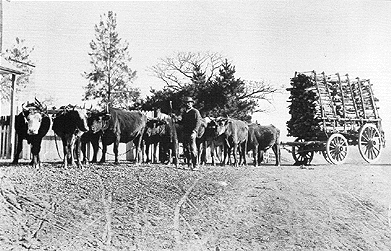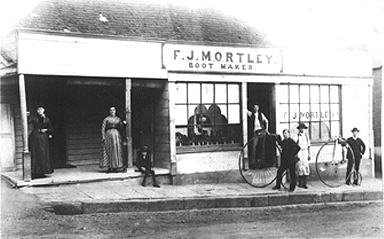TEXTILES
The manufacturing of cloth was productive
particularly with a shortage of cloth in the colony. Experiments with flax
from the Hawkesbury took place in 1799 when samples of cloth using native grown
flax were manufactured into linen yarn which was then woven into fabric. Government
officials had great hopes for the flax industry.
The House of Industry at the Female Factory in Parramatta was producing over 4,500 metres per annum. In 1803 a master weaver was employed at Parramatta and later Governor Macquarie supported the expansion of this industry. John Blaxland built a tweed factory on his property at Newington in the period 1816-1817, processing local wool supplies.
During the 1830s there were a number of local persons employed in the manufacturing of blankets and factory cloth in the Hawkesbury however by 1836, this particular type of manufacturing had ceased in the district.
The Byrnes Brothers of Parramatta commenced a large cloth making business in the 1840s and during 1847 were producing over 22,000 yards of cloth and tweed with their steam driven equipment. During the 1830s, Matthew Kirby operated a woollen mill at Lower Minto. In 1885 a flour mill was adapted toa woollen mill in Camden but was destroyed by fire several years later and the business was transferred to Bowenfels.
The Darling Mills originally established as a flour mill was converted to a tweed factory in the 1870s. Merchandise ranged from blankets to the Australian Horse uniforms. The factory was again converted in the 1960s and carpet making commenced. The mill closed in 1975. In 1909 the Challenge Woollen Mill opened in the Liverpool district manufacturing blankets, flannel and woven cloth. It was demolished in the 1970s.
Villawood Textiles operated from the Riverstone Meatworks from the late 1940s. Hand knitting yarns were produced and some wool exported. It closed in 1978. The Schuess Knitting Mills commenced operations in the Baulkham Hills district in 1942. The Bonds cotton spinning mill opened at Pendle Hill in 1923 and the railway station was established to serve this site.
TANNERIES
 Tanning is the process of converting
animal skins to leather and because large amounts of water were required
for this process most tanning yards operated close to a water supply . Andrew
Thompson was operating a tannery in the early 1800s at South Creek near Windsor.
The tanning industry boomed quickly in the colony as leather was scarce,
especially when native wattle bark was effectively used to cure hides. By
the 1830s six tanneries were recorded in the Windsor district and by the
late 1870s this had increased to thirteen.
Tanning is the process of converting
animal skins to leather and because large amounts of water were required
for this process most tanning yards operated close to a water supply . Andrew
Thompson was operating a tannery in the early 1800s at South Creek near Windsor.
The tanning industry boomed quickly in the colony as leather was scarce,
especially when native wattle bark was effectively used to cure hides. By
the 1830s six tanneries were recorded in the Windsor district and by the
late 1870s this had increased to thirteen.
Parramatta had several successful tanneries including Charles Jackson who was established near the Hunt & Darling Mills Creeks. In 1831 three tanning pits were operating at Minto & Airds. The main tannery businesses were run by Hugh Murphy, William Bursill and Charles Huckstepp in the Campbelltown district from the 1840s.
Several tan pits were operating in the Liverpool area including shoemakers Hatfield and Greaves in the 1830s.
From the 1840s and for over 100 years, tanning was a major industry in St Marys. Thomas Paskin and Alexander Simpson established the first tanyards. Several large tanneries were located in Auburn and Smithfield in the latter half of the century.
Transporting timber for the tanning industry last century at North Richmond. Photo acknowledgement : Hawkesbury City Council Library.
SHOE & BOOTMAKERS
 Usually shoe & bootmakers operated
close to leather supplies and tanneries. During the 1850s there were several
shoe and bootmakers in Windsor and Richmond, including Frederick Mortley
set up a thriving boot factory in Windsor in 1868 and employed up to twenty
men. John Lane set himself up in the boot industry during the 1840s and was
located on the corner of George and Fitzgerald Streets, he continued in the
business until his retirement in 1906.
Usually shoe & bootmakers operated
close to leather supplies and tanneries. During the 1850s there were several
shoe and bootmakers in Windsor and Richmond, including Frederick Mortley
set up a thriving boot factory in Windsor in 1868 and employed up to twenty
men. John Lane set himself up in the boot industry during the 1840s and was
located on the corner of George and Fitzgerald Streets, he continued in the
business until his retirement in 1906.
Some shoemakers in the Campbelltown district in the 1820s included Samuel Lovely and Edward Taylor. Some of these were also involved in the tanning trade.
F. J. Mortley was one of the prominent shoe & bootmakers in Windsor, late last century. Photo Acknowledgement : Hawkesbury City Council Library.